Genre: Graphic Adventure Developer: Game Arts Publisher: Game Arts Players: 1 Released: 1994
I have to admit that I’m not much of a fan of off-the-wall anime comedies, and only a few, like Project A-ko, have managed to capture my attention. I’m more of a mech and super power anime fellow, and I tend to stick to movies rather than shows. My anime collection has virtually nothing more than a few episodes long, and most of it has a lot of explosions and big robots.
It was with a mixture of curiosity and skepticism then, that I decided to try out Urusei Yatsura: My Dear Friends. I’ve been on bit of a Mega CD run lately, wanting to delve deeper into the add-on’s import library. I’ve tried RPGs and action titles, so why not a graphic adventure? My background knowledge of the anime series is somewhat limited, and while I have seen a few episodes, I’m not really familiar with all the characters. A quick look online brought me up to speed on what was going on, so I felt it was time to check out another import.
Several online sources describe the plot as one involving a game of intergalactic tag, where girl-hungry Ataru becomes Earth’s champion. Nothing in the game seems to reflect this, however, and the story appears to involve Chara’s arguing with Ataru. As their fighting escalates, things get really weird. Chara turns into a teenage girl, a pentagram of dimensional portals is found throughout the city, and Lum gets trapped in a giant, extra-dimensional toybox. Seriously, I couldn’t make this stuff up. As with most anime though, I tend to ignore the ridiculous plots and concentrate on the character interactions and dialogue. My Dear Friends excels in both these areas, and though I can’t understand what’s being said, I can tell that fans of the cartoon series aren’t going to be disappointed.
The first thing players are going to notice is just how smooth everything runs. There are no long loading pauses, and the animation is crisp and clean. The multiple cut scenes are full-screen and run long, and while this does mean that one spends more time looking at a movie than actually playing, that’s part and parcel of the genre, so no one should be surprised. Given how nice everything looks and animates and considering the obvious amount of love Game Arts put into making the game as faithful to the source material (even the original anime voice actors are here!), I found My Dear Friends to be a welcome change from the grainy, tiny FMV titles that we tend to find in the U.S. Sega CD library.
The game was obviously designed so that the gameplay would complement the aesthetics, and for that reason it’s very basic. My Dear Friends is Mega Mouse compatible, but I wasn’t able to try it out with an American mouse, so I can’t say if the two work. Either way, it’s not really needed, since the onscreen cursor moves quite fast, and there’s not really many options to click anyway. A three-button controller will work just fine. The A button accesses the inventory screen, where items needed to interact can be used. Ataru’s diary is also here, and it’s needed to save up to four different games. The B button alternates the cursor between looking at scenery (eye), talking to people (mouth), and touching/taking items (hand). Some characters must be spoken to, while others have their dialogues activated by observing them or handing them an item. Players who get stuck in any particular area can be sure it’s because they didn’t activate the necessary dialogue to prompt the new interaction. For example, I needed to get a green gelatin from Megane the cook, but he wouldn’t give it to me even though I was trying to hand over the item that would prompt him to do so. It turns out that I hadn’t activated the dialogue in a previous conversation that made the character request the gelatin. I went back and talked to him again, and Megane accepted my item and turned over the gelatin.
That kind of thing is what really makes My Dear Friends so much fun. The level of interactivity found throughout the game is truly impressive. Virtually everything can be manipulated, from dresser drawers to doors and windows and pots on the stove. Throughout his adventure, Ataru can acquire all kinds of items by sticking his nose in other people’s stuff. He can even find three game cartridges that can actually be played on his “Oni” game system in his living room! There’s a simplistic fighter, a Defender clone, and a mini-game that has Kotatsuneko the giant cat collecting as much food as he can before the timer expires. All three games are very basic, but it’s cool to be able to actually take a break from the story and check these little bonuses out. And this was almost half a decade before Shenmue!
Overall, the only thing keeping me from really enjoying My Dear Friends as much as I should is my lack of Japanese knowledge. I really would like to understand what’s being said in all the dialogue, and I can tell that there are a ton of funny moments all through the game by the incredible cut scenes. Aside from the language barrier, my only other complaint might be the short length of the whole adventure, but like the best adventure games, the actual duration of play depends on the player. Those who want to see the end quickly can virtually finish the game in one sitting, but those out for the whole experience can take hours just wandering around each location and interacting with everything. There are a ton of cut scenes to be seen during these “side quests,” and it makes the game feel so much more complete.
I can wholeheartedly recommend Urusei Yatsura: My Dear Friends to gamers who aren’t necessarily fans of the show. It’s a smart, well-executed graphic adventure that really takes advantage of the Sega CD’s capabilities. Don’t let the Japanese dialogue and text overcome curiosity. Find a copy and enjoy the quirky humor!
SCORE: 8 out of 10

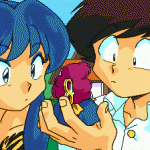
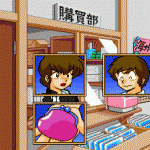
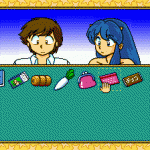
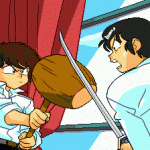
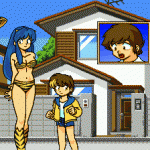
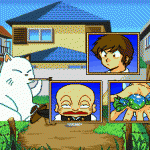
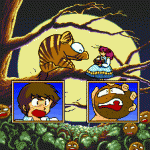
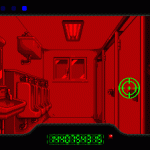
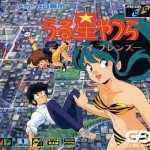
Is this game only in japanese?
hopefully someone will do a translated version so we can put it on our Everdrives…